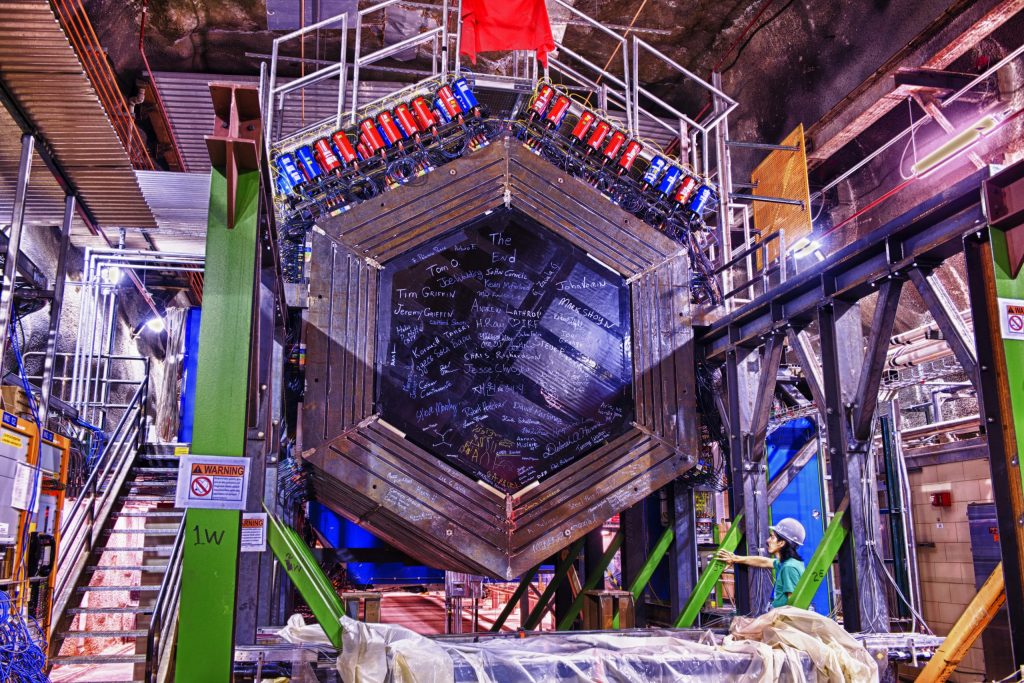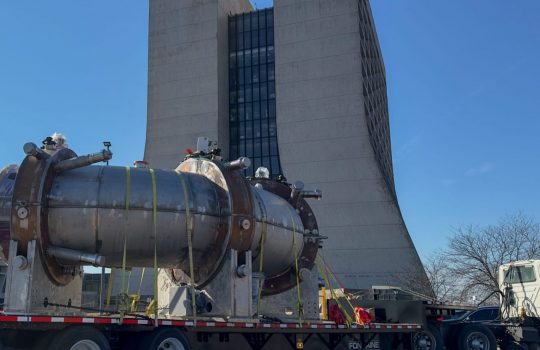Scientists study tiny particles called neutrinos to learn about how our universe evolved. These particles, well-known for being tough to detect, could tell the story of how matter won out over antimatter a fraction of a second after the Big Bang and, consequently, why we’re here at all.
Getting to the bottom of that split-second history means uncovering the differences, if any, between the neutrino and its antimatter counterpart, the antineutrino.
The MINERvA neutrino experiment at Fermilab recently added some detail to the behavior profiles of neutrinos and antineutrinos: Scientists measured the likelihood that these famously fleeting particles would stop in the MINERvA detector. In particular, they looked at cases in which an antineutrino interacting in the detector produced another particle, a neutron — that familiar particle that, along with the proton, makes up an atom’s nucleus.
MINERvA’s studies of such cases benefit other neutrino experiments, which can use the results to refine their own measurements of similar interactions.
It’s typical to study the particles produced by the interaction of a neutrino (or antineutrino) to get a bead on the neutrino’s behavior. Neutrinos are effortless escape artists, and their Houdini-like nature makes it difficult to measure their energies directly. They sail unimpeded through everything — even lead. Scientists are tipped off to the rare neutrino interaction by the production of other, more easily detected particles. They measure and sum the energies of these exiting particles and thus indirectly measure the energy of the neutrino that kicked everything off.
This particular MINERvA study — antineutrino enters, neutron leaves — is a difficult case. Most postinteraction particles deposit their energies in the particle detector, leaving tracks that scientists can trace back to the original antineutrino (or neutrino, as the case may be).
But in this experiment, the neutron doesn’t. It holds on to its energy, leaving almost none in the detector. The result is a practically untraceable, unaccounted energy that can’t easily be entered in the energy books. And unfortunately, antineutrinos are good at producing energy-absconding neutrons.
Researchers make the best of missing-energy situations. They predict, based on other studies, how much energy is lost and correct for it.
To give the scientific community a data-based, predictive tool for missing-energy moments, MINERvA collected data from the worst-case situation: An antineutrino strikes a nucleus in the detector and knocks out the untraceable neutron so nearly all of the energy bestowed to the nucleus goes “poof.” (These interactions also produce positively charged particles called muons which signal the antineutrino interaction.) By studying this particular disappearing act, scientists could directly measure the effects of the missing energy.

Scientists at Fermilab use the MINERvA to make measurements of neutrino interactions that can support the work of other neutrino experiments. Photo: Reidar Hahn
Other researchers can now look for these effects, applying the lessons learned to similar cases. For example, researchers on Fermilab’s largest operating neutrino experiment, NOvA, and the Japanese T2K experiment will use this technique in their antineutrino measurements. And the Fermilab-hosted international Deep Underground Neutrino Experiment, centerpiece of a world-leading neutrino program, will also benefit from this once it begins collecting data in the 2020s.
The neutron production case is just one type of missing-energy interaction, one of many. So the model that comes out of this MINERvA study is an admittedly imperfect one. There can’t be a one-size-fits-all-missing-energy-scenarios model. But it still provides a useful tool for piecing together a neutrino’s energy — and that’s a tough task no matter what particles come out of the interaction.
“This analysis is a great testament to both the detector’s ability to measure neutrino interactions and to the collaboration’s ability to develop new strategies,” said Fermilab scientist and MINERvA co-spokesperson Deborah Harris. “When we started MINERvA, this analysis was not even a gleam in anyone’s eye.”
There’s a bonus to this recent study, too, one that bolsters an investigation conducted last year.
For the earlier investigation, MINERvA focused on neutrino (instead of antineutrino) interactions that knocked out proton-neutron pairs (instead of lone neutrons or protons). In a detector such as MINERvA, a proton’s energy is much easier to measure than a neutron’s, so the earlier study presumably yielded more precise measurements than the recent antineutrino study.
How good were these measurements? MINERvA scientists plugged the values of the earlier neutrino study into a model of this recent antineutrino study to see what would pop out. Lo and behold, the adjustment to the antineutrino model improved its ability to predict the data.
The combination of the two studies gives the neutrino physics community new information about how well models do and where they fall short. Searches for the phenomenon known as CP violation — the thing that makes matter special compared to antimatter and enabled it to conquer in the post-Big Bang battle — depend on comparing neutrino and antineutrino samples and looking for small differences. Large, unknown differences between neutrino and antineutrino reaction products would hide the presence or absence of CP signatures.
“We are no longer worried about large differences, and our neutrino program can work with small adjustments to known differences,” said University of Minnesota–Duluth physicist Rik Gran, lead author on this result.
MINERvA is homing in on models that, with each new test, better describe both neutrino and antineutrino data — and thus the story of how the universe came to be.
These results appeared on June 1, 2018, in Physical Review Letters.



